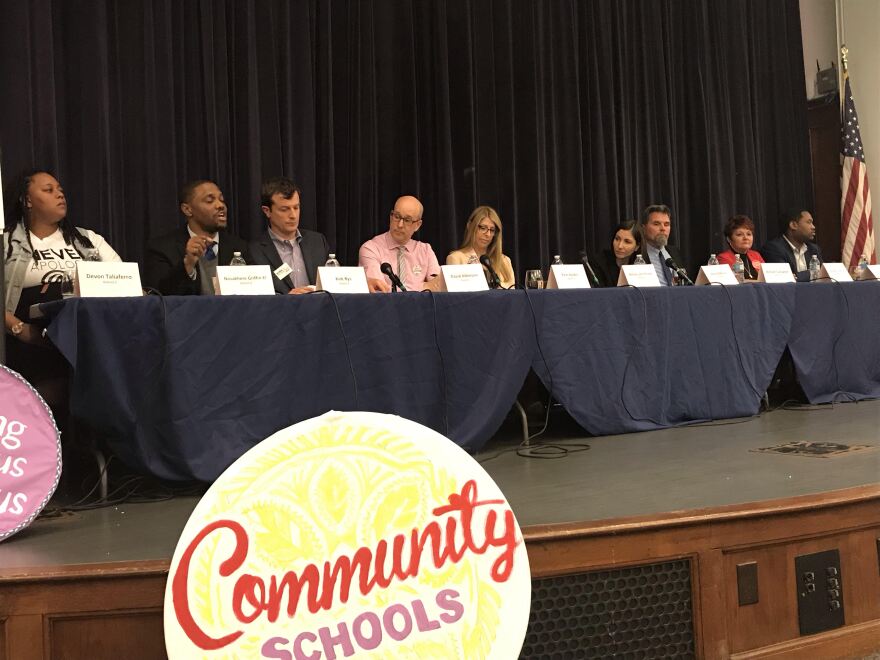Nine candidates vying for four seats on the Pittsburgh Public Schools board mostly agree on what the biggest issues are facing the state's second largest school district. The biggest differences are in how they might go about addressing them.
The first forum before the May 21 primary was hosted by Great Public Schools Pittsburgh, a coalition of groups including the Pittsburgh Federation of Teachers, One Pennsylvania, the Education Rights Network, the Pennsylvania Interfaith Impact Network and SEIU Healthcare Pennsylvania.
The Pittsburgh Public School District controls a $650 million budget and the nine members enact everything from policies that determine curricula, to how students are disciplined. Nearly 24,000 students attend Pittsburgh Public Schools.
Candidates
Only one of the races includes an incumbent. Kevin Carter who represents parts of the North Side in district 8 is running unopposed. Two candidates in the district 4 race, which covers East End neighborhoods including Point Breeze and Squirrel Hill, are on both Democratic and Republican ballots, so there is a chance the two could face off again in the November general election.
Four candidates are competing for longtime board member and former president Regina Holley’s seat representing district 2: David Atkinson, Nosakhere Griffin-El, Kirk Rys and Devon Taliaferro. The district represents parts of the North Side, Highland Park, East Liberty, Lawrenceville and Bloomfield.
Three are running for current board president Lynda Wrenn’s district 4: Anna Batista, Pam Harbin and Ashley Lynn Priore. Priore did not attend the forum. The district covers eastern neighborhoods including parts of Oakland, Point Breeze and parts of Shadyside.
Two are seeking the district 6 seat occupied by Moira Kaledia: Bill Gallagher and Heather Fulton. The district covers southern neighborhoods including Brookline, Beechview, Banksville, Mt. Washington and East Carnegie.
Find more about each candidate and their answers to questions from education advocacy group A+ Schools here.
Issues
Candidates were asked to weigh in on how they would commit to quality and equity as a member of the district’s oversight body. Paraphrased answers from each candidate are included below to three of the questions asked.
Candidates were asked what their views were on closing schools.
- Taliaferro: She’s a graduate of Wilkinsbug High School, a school that closed in 2016, a school she says the community should have. “We need to look at other options when looking to close a school.”
- Griffin-El: “When you close a school, you close the culture of the community.” He said that is problematic.
- Rys: He noted that closing a school is harmful to a community, but that board members are charged with being financial stewards. With population loss, he said the board would have to consider its options.
- Atkinson: Wants to realign the school feeder pattern that determines where students go to school as a way to sustain the district as enrollment and demographics change.
- Harbin: “Displacement is violence and closing a school is violence.” She noted that the district closed schools in the Hazelwood neighborhood where Propel Charter Schools then opened a school.
- Batista: Said a school closing shouldn’t be considered unless it is absolutely necessary and that there is data to prove it. If that conversation happens there has to be, “significant input from the community for a long time.”
- Gallagher: Said the district has to make schools better so that families won’t leave the district.
- Fulton: Closing schools is disruptive and bad for families. A school shouldn’t close unless that building is falling down.
- Carter: “No.”
Should school police officers be allowed to carry guns?
- All candidates said “no."
What is one policy or practice you would implement to stop the school to prison pipeline? (A term used to describe a link between a disproportionate use of discipline often against students of color and low income students that leads to future interaction with the criminal justice system.)
- Taliaferro: Reinforcing the district’s use of restorative practice.
- Griffin-El: Putting two students on the school board to vote on policies that affect them.
- Rys: Reinforcing the district’s use of restorative practice.
- Atkinson: Developing protocols for truancy and develop more supports through attendance programs, working with the courts, the district and the county.
- Harbin: More staff in schools. “Suspensions happen during lunch and recess when there aren’t enough adults in the building.”
- Batista: Make sure the suspension ban (for non-violent infractions in first and second grade) is working, and, “when we have resounding success, expand it to more grades.”
- Gallagher: “Smaller classrooms so we can establish relationships. That will solve a lot of the problems.”
- Fulton: More people in our buildings, more social workers and paraprofessionals.
- Carter: Eliminating racial bias and “blowing up” the student code of conduct
Another candidate forum hosted by education advocacy group A+ Schools is scheduled for Wednesday, April 24 at the Kaufmann Center in the Hill District.




